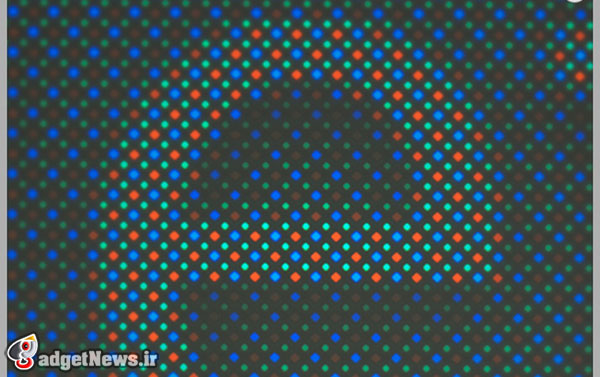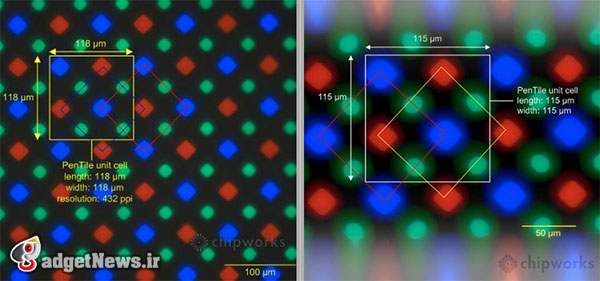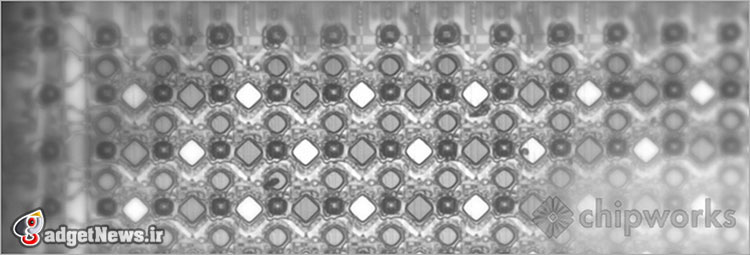
بخش تولید نمایشگرهای سامسونگ به تازگی اطلاعاتی از صفحه نمایش جدید AMOLED متعلق به گلکسی S5 منتشر نموده است. همچنین تحلیلی از جانب Chipworks در مورد این صفحه نمایش ارائه شده که در ادامه به آن میپردازیم. پس با ما همراه باشيد
از زمان معرفی گلکسی S4، سامسونگ از ماتریس Diamond Pentile استفاده میکند، گلکسی S5 هم از همین ماتریس الماسی با تغییراتی جزئی ولی قابل توجه استفاده مینماید. برخلاف نمایشگرهای السیدی RGB که در آنها هر پیکسل از سه سابپیکسل قرمز، سبز و آبی تشکیل میشود، نمایشگرهای PenTile از سابپیکسل های کمتری استفاده مینمایند. در گلکسی S4 سابپیکسلهای الماسی برای رنگهای آبی و قرمز و یک سابپیکسل به شکل بیضی برای رنگ سبز داشتیم ولی در گلکسی S5 تمامی سابپیکسلها به شکل الماس (لوزی شکل) هستند و این اولین تفاوت بین نمایشگرهای این دو مدل است.

نحوه چیدمان پیکسلها همچنان مانند گلکسی S4 است. در هر بلوک به شکل الماس (لوزی) که شامل 4 سابپیکسل است، دو سابپیکسل سبز رنگ، یک قرمز رنگ و یک سابپیکسل آبی رنگ وجود دارد. البته اندازه واقعی سابپیکسلها تغییر کرده است. در گلکسی S4 سابپیکسل آبی رنگ به شکل معناداری بزرگتر از سایر رنگها بود و دلیل آن پایین بودن کارایی انتشار این رنگ فرض میشد. اگر واقعا بزرگتر بودن سابپیکسلهای آبی رنگ بخاطر دلیلی که ذکر شد باشد، به نظر میرسد در گلکسی S5 چنین مسائلی رفع شدهاند چرا که اندازه سابپیکسلهای آبی در S5 با قرمزها برابر است.

در عمل این نکته ممکن است به اعمال تغییراتی در فیلترهای OLED که توسط سامسونگ مورد استفاده قرار می گیرند، منجر شده باشد. این نکته بسیار حائز اهمیت است چرا که شاید این عامل موجب موفقیت چشمگیر سامسونگ در روشنایی تصویر، شده باشد. سامسونگ اعلام کرده است که گلکسی S5 تحت شرایط نور محیطی 47 درصد روشنتر از گلکسی S4 است.

تصاویر صفحهنمایش گلکسی S5 و چیدمان الماسی پیکسل های آن مسحور کننده است، اینطور نیست؟
منبع : phonearena
Samsung Galaxy S5: deeper dive in the Diamond PenTile matrix reveals the secrets of the brightest AMOLED display
Samsung Display has just unveiled a lot of the inner works of the new AMOLED display of the Galaxy S5, but now we have even deeper insights coming from an ongoing dissection of the display by Chipworks.Samsung has been using a Diamond-shaped PenTile matrix since the Galaxy S4, and while the Galaxy S5 also features a Diamond matrix, this time there are some slight, but noticeable modifications. Unlike traditional RGB LCD displays where each pixel is made out of a red, green, and blue sub-pixel, PenTile displays use less sub-pixels. In the Galaxy S4 we had diamond-shaped sub-pixels for the blue and red colors, and an oval-shaped green sub-pixel. In the Galaxy S5, all sub-pixels are now in the diamond shape, and that’s the first change.The actual arrangement of the pixels has not changed from the S4 – in every 4 sub-pixel diamond shaped block, we have two green sub-pixels, one red and one blue sub-pixels. However, the actual size of the sub-pixels has changed. In the Galaxy S4, the blue sub-pixel was larger than all others by a huge margin, and it was assumed that this is because of the lowest emission efficiency. If that was indeed the reason, it seems that now, the Galaxy S5 has largely fixed such issues, as the blue sub-pixel now matches the red one in size.This in turn, should have likely resulted in some changes in the OLED filters that Samsung uses. This is important, as this change might be the factor that allows for Samsung’s huge breakthroughs in display brightness. Samsung says its Galaxy S5 is up to 47% brighter than the Galaxy S4 under ambient light, and DisplayMate has measurued up to 25% boost in brightness under less challenging conditions.Right below you get to see an intimate close-up look of the Galaxy S5 display with its new Diamond pixel arrangement: mesmerizing, isn't it?
 گجت نیوز آخرین اخبار تکنولوژی، علم و خودرو
گجت نیوز آخرین اخبار تکنولوژی، علم و خودرو 





